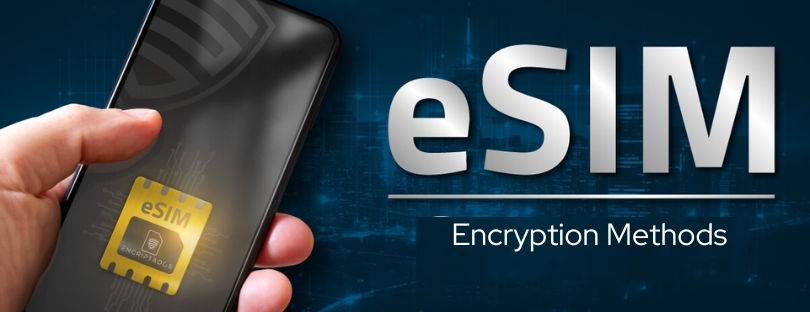
eSIM Encryption Methods: Safeguarding Your Digital Identity
In today’s digitally connected world, the security of mobile communications is more critical than ever. eSIM (Embedded Subscriber Identity Module) technology has emerged as a leading solution for seamless, secure, and flexible mobile connectivity. However, as the adoption of eSIMs grows, so does the need for robust security measures to protect user data and ensure secure communication. One of the foundational aspects of eSIM security is encryption, which safeguards both user information and data transmission. This article delves into the various encryption methods used in eSIM technology, exploring their importance and how they work to provide a secure mobile experience.
Symmetric encryption is a fundamental method used in eSIM security. Here, a single key is used for both encrypting and decrypting data. This method is known for its speed and efficiency, making it suitable for securing large volumes of data during transmission between eSIM devices and servers.
- AES (Advanced Encryption Standard): A widely adopted symmetric encryption algorithm, AES is used in eSIMs to protect communication channels. It employs block cipher techniques and is highly secure, with key sizes varying from 128 to 256 bits, offering different levels of security based on the need.
Asymmetric Encryption for Enhanced Security
Asymmetric encryption, or public-key cryptography, plays a crucial role in eSIM security, providing a higher level of protection:
- RSA (Rivest–Shamir–Adleman): RSA is often used for initial key exchange or digital signatures within eSIM contexts. It uses two keys: a public key for encryption and a private key for decryption. This method ensures that even if the public key is known, the private key remains secure, safeguarding the data.
- Elliptic Curve Cryptography (ECC): ECC offers similar security levels to RSA but with much smaller key sizes, making it ideal for eSIMs where computational resources might be limited. ECC secures data by leveraging the mathematical properties of elliptic curves over finite fields, which are difficult to crack even with advanced computing power.
Public Key Infrastructure (PKI)
PKI is integral to eSIM security, forming the backbone of trust and authentication.
- Digital Certificates: PKI uses certificates to validate the identity of the eSIM and the network it communicates with. These certificates are signed by a trusted Certificate Authority (CA), ensuring that only authorized entities can access or modify the eSIM profile.
- Key Management: PKI involves managing cryptographic keys securely, including key generation, distribution, storage, and revocation. This process ensures that keys used in eSIMs are protected throughout their lifecycle.
Secure Communication Protocols
eSIMs employ various communication protocols to ensure data integrity and confidentiality.
- SSL/TLS: Secure Sockets Layer (SSL) and Transport Layer Security (TLS) are used to create encrypted connections between eSIMs and servers. These protocols are crucial for secure data transmission, especially during profile downloads or updates.
- HTTPS: For web-based interactions involving eSIM management, HTTPS ensures that the data exchanged is encrypted, preventing man-in-the-middle attacks.
Advanced Techniques for Future-Proofing
- Quantum-Resistant Algorithms: With the advent of quantum computing, which could potentially break traditional encryption, some forward-looking eSIM implementations are considering or adopting quantum-resistant algorithms. These algorithms are designed to withstand attacks from quantum computers, ensuring long-term security.
- Quantum Key Distribution (QKD): Though still in the experimental stages for eSIMs, QKD could provide unbreakable encryption by leveraging the principles of quantum mechanics to securely distribute encryption keys.
Encryption in Data at Rest and in Transit
- Data at Rest: eSIMs ensure that stored data, like user credentials and network profiles, are encrypted within the device’s secure element, making it unreadable to unauthorized users.
- Data in Transit: All communications, whether for authentication or data exchange, are encrypted to prevent interception or tampering by third parties.
Best Practices for eSIM Encryption
- Regular Key Updates: Change encryption keys periodically to maintain security.
- Centralized Key Management: Use a centralized system for managing keys to ensure consistency and security across all eSIM deployments.
- User Education: Inform users about the importance of secure practices like not sharing device access or personal information that could lead to security breaches.
Conclusion
The encryption methods used in eSIM technology are both diverse and sophisticated, designed to protect user data across various scenarios. From symmetric to asymmetric encryption, coupled with robust PKI systems and secure communication protocols, eSIMs offer a high level of security that is critical in today’s digital, mobile-first world. As technology evolves, so too will the encryption methods, ensuring that eSIMs remain a secure choice for mobile connectivity.
- AIRALO
-
eSIM for
Europe
39 countries
-
1 GB – 7 days – €4.27
3 GB – 30 days – €11.09
10 GB – 30 days – €31.57
- AIRHUB
-
eSIM for
Europe
34 countries
-
1 GB – 7 days – €2.99
3 GB – 30 days – €5.12
10 GB – 30 days – €11-09
- aloSIM
-
eSIM for
Europe
32 countries
-
1 GB – 7 days – €5.00
3 GB – 30 days – €13.00
10 GB – 30 days- €36.00
- GigSky
-
eSIM for
Europe
36 countries
-
1 GB – 7 days – €6.99
3 GB – 15 days – €11.19
10 GB – 30 days – €27.99
- iRoamly
-
eSIM for
Europe
39 countries
-
1 GB – 7 day – €6.83
3 GB – 15 days – €10.24
10 GB – 30 days – €18.77
- Maya Mobile
-
eSIM for
Europe
34 countries
-
1 GB – 7 days – –
5 GB – 15 days – €5.99
10 GB – 30 days- €13.99
- NOMAD
-
eSIM for
Europe
36 countries
-
1 GB – 7 days – €4.71
3 GB – 15 days – €10.27
10 GB – 30 days – €15.41
- UBIGI
-
eSIM for
Europe
29 countries
-
500 MB – 1 day – €2.00
3 GB – 30 days – €8.00
10 GB – 30 days – €19.00
- VOIA
-
eSIM for
Europe
34 countries
-
1 GB – 7 days – €2.69
3 GB – 15 days – €5.05
10 GB – 30 days- €11.70


















